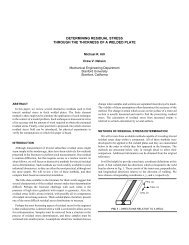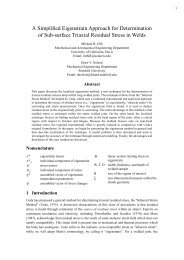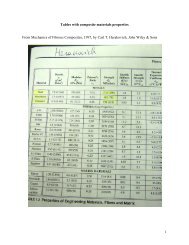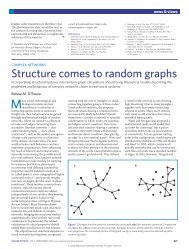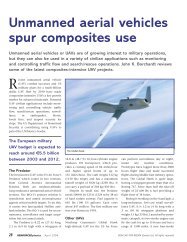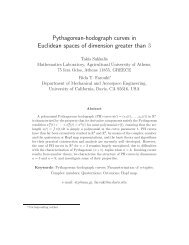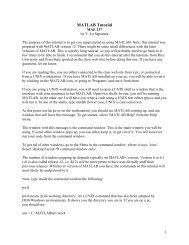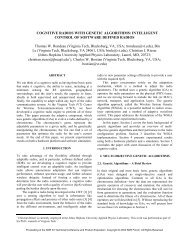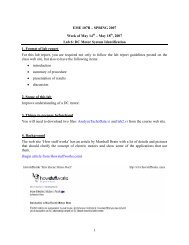Torsion
Torsion
Torsion
You also want an ePaper? Increase the reach of your titles
YUMPU automatically turns print PDFs into web optimized ePapers that Google loves.
144 CHAPTER 5. TORSION<br />
The general solution of the differential equation is g(η) = C1 sinh γη+C2 cosh γη−b2Gκ1, where C1 and C2<br />
are the integration constants that can be evaluated with the help of the boundary conditions, g(η = ±1) = 0.<br />
If follows that g(η) = (cosh γη/ cosh γ − 1) b2Gκ1, and the stress function becomes<br />
<br />
cosh γη<br />
Φ(η, ζ) = − 1 (ζ<br />
cosh γ 2 − 1) b 2 Gκ1.<br />
This stress function is shown in fig. 5.17.<br />
Φ<br />
0.25<br />
0.2<br />
0.15<br />
0.1<br />
0.05<br />
0<br />
1<br />
0.5<br />
0<br />
x 3<br />
−0.5<br />
−1<br />
−2<br />
−1<br />
x 2<br />
0<br />
1<br />
2<br />
x 3<br />
1<br />
0.8<br />
0.6<br />
0.4<br />
0.2<br />
0<br />
−0.2<br />
−0.4<br />
−0.6<br />
−0.8<br />
−1<br />
−2 −1.5 −1 −0.5 0<br />
x<br />
2<br />
0.5 1 1.5 2<br />
Figure 5.17: Left figure: stress function Φ. Right figure: distribution of shear stress over cross-section. The<br />
arrows represent the shear stresses; the contours represent constant values of the stress function Φ. a = 2,<br />
b = 1.<br />
For this section bound by a single curve, the externally applied torque is given by eq. (5.73)<br />
<br />
M1 = 2 Φ dA = 16ab3<br />
<br />
tanh γ<br />
1 − Gκ1.<br />
3 γ<br />
A<br />
Since the sectional torsional stiffness J is defined as the constant of proportionality between the torque and<br />
the twist rate, it follows that<br />
J = 16ab3<br />
<br />
tanh γ<br />
1 − G.<br />
3 γ<br />
(5.84)<br />
The stress field is now readily found from the derivatives of the stress function<br />
τ12 = 3 M1<br />
8 ab2 cosh γη/ cosh γ − 1<br />
1 − (tanh γ)/γ<br />
ζ; τ13 = − 3 M1<br />
16 a2b γ sinh γη/ cosh γ<br />
1 − (tanh γ)/γ (ζ2 − 1),<br />
where the twist rate is expressed in terms of the applied torque as κ1 = M1/J. The shear stress distribution<br />
is displayed in fig. 5.17.<br />
Comparison of approximate solutions<br />
The solution of the last two examples are now compared. Instead of using a and b which are the half-lengths<br />
of the cross-section, the full length of the section a ′ = 2a and the width b ′ = 2b will be used instead. The<br />
nondimensional torsional stiffnesses are<br />
J1<br />
a ′ b ′3 =<br />
G 5<br />
18<br />
1<br />
1 + (b ′ /a ′ ;<br />
) 2<br />
J2<br />
a ′ b ′3 =<br />
G 1<br />
<br />
1 −<br />
3<br />
<br />
tanh γ<br />
. (5.85)<br />
γ<br />
J1 is the torsional stiffness obtained with the crude solution, see eq. (5.83), whereas J2 is that obtained<br />
with the refined solution, see eq. (5.84). For a very thin strip, b → 0 and a/b → ∞. It follows that





